During several visits over the course of a year it looked like a large berm of tall grass, about the size and height of a one-story house. For some reason it was trimmed back and began to fruit which led to its general identification: Pandanus. That naturally leads to a Pandanus problem: Which species is it?
The genus Pandanus has over 500 members and are found from West Africa eastward to Hawaii, from coastal areas up mountains to 10,000 feet, from species a few feet high to 10o-foot trees. There are many natural species of Pandanus and several cultivated varieties. They are and have been a major textile and food crop throughout the Pacific region and figure significantly in Polynesian culture.
Also called “Pandans” they fall into two large subgroups, those used for the fruit and those used for the seeds. Some fall in both groups. The ones with edible fruit and or seeds are usually either oily or consist mainly of carbohydrates. That group, generally known as “marita” is mainly Pandanus conoideus and perhaps Pandanus englerianus and Pandanus magnificus. Not every one agrees that the last two are separate species. The edible fruit is mostly red or yellow. Generally after processing it is used as a spread like butter. Another set in this subgroup is Pandanus tectorius which also includes Pandanus leram and the cultivated Pandanus fischerianus.
The second major food group of Pandanus produce edible seeds, some edible raw, some edible after proper cooking. The prime species for that is the ‘karuka’ of New Guinea, which can be either Pandanus brosimos or Pandanus julianettii. The seeds are oily, contain protein, and are on par with coconuts in their use and value. Some experts think all Pandanus species probably produce edible seeds but no one really knows. Trees begin to fruit between seven and eight years old and will produce for some 60 years. When they do fruit it takes two to six months for the fruit to ripen depending upon the species. Those used for the spread take two to three months to ripen, seed bearing ones four to six.
Besides carb or oil producing is there any other division we should be aware of? Yes. Wild versions can contain large amounts of calcium-oxalate crystals (raphides and rhomboids) which can irritate the mouth. Heating can break them down. In cultivated versions the raphides are reduced or missing so that some forms can be eaten raw. Minus the calcium oxalates Pandanus can be quite nutritional. The fruit flesh of the Pandanus tectorius, for example, contains per 100 gram of edible portion: water 80 g, protein 0.4 g, fat 0.3 g, carbohydrates 19 g, fibre 0.3 g. Oven-dried seeds of karuka (Pandanus brosimos) contain per 100 g edible portion: water 6—10 g, protein 8.5—14 g, fat 0.4—37 g, fibre 5—12 g, the remainder ash and carbohydrates. In those what is eaten is the terminal bud, or the growing end, like the heart of palm.
Pandans used for textiles include Pandanus dubius, Pandanus kaida, and Pandanus tectorius. Various products are made from them as bags, hats, pocketbooks, umbrellas mats, dolls even sails. Pandans did not escape the attention of the oldest still extant foraging group on earth, the Aboriginals of Australia. They used the top leaves for baskets, ate the fruit, and used dead trunks to carry fire with them, smouldering like an all-day, bat-sized cigarette. At least six species have been exported to warm areas of the world. Several species of Pandanus have been planted in Florida including Pandanus amaryllifolius, Pandanus baptistii, Pandanus sanderi, Pandanus tectorius, Pandanus utilius and Pandanus veitchii. Some Pandanus grow in Texas (definitely P. utilis) and many in Hawaii and Puerto Rico.
Among those in Florida Pandanus tectorius, aka Nicobar Breadfruit, is native to the seacoast from southern China to tropical Australia and Polynesia. Common in Hawaii, it’s a tree to 25 feet with spreading branches, numerous prop roots, and forms large, dense thickets. The leaves are evergreen, spirally set, strap-like to five feet long. Their edges are spiny and the leaves droop. The female flower is a single spike with a yellow spathe; male flowers are on a separate plant, very fragrant, composed of many dangling spikes in long, white spathes. The fruit is a globose, knobby head to ten inches long, orange-yellow, breaking apart when fully ripe, exposing soft edible pulp in the center. The terminal bud is also edible. Leaves are used for thatching and mats. The fleshy pulp of the fruit may be eaten raw, cooked, or made into flour, paste and thick flat cakes. Flour is often mixed with palm syrup or diluted with water to make a popular drink. Tender, white bases of the young leaves are eaten raw or cooked. Aerial roots are cooked and eaten or processed into beverage. Flowers and pollen are edible, too. Seeds can be made edible after processing. It’s also called Pandanus odoratissimus though that might just be a variation. Botanists can’t agree. Pandanus tectorius can withstand drought, strong winds, salt spray and propagates readily from seed or branch cuttings,
Pandanus amaryllifolius, uncommon in Florida, is the only species in the genus with fragrant leaves. It grows between 1.5 and 3 feet tall, sometimes to six feet. When older it produces aerial roots and stilt roots to support itself from falling. Leaves are slender, lush-green and smooth-edged up to 20 inches long. It resembles an amaryllis, hence the name. Leaves have a depressed center running from the base outwards gradually flatten towards the tip. Fragrant young leaves are cooked as a vegetable or used as a condiment. Fresh or dried leaves add a musty odor and flavor and green color to tofu, jellies, doughs, curries, syrups, sauces, coconut rice, and sweets. It is also added to cooking oil before cooking as a spice. The leave are used to wrap food such as rice dumplings. Sometimes called Pandanus latifolius. There is a bit of a schism with the Fragrant Pandan. Some insist the leaves are used only for flavoring and removed. Others insist young leaves can be cooked and eaten. As folk dancers say when they encounter a variation in a dance they know… “different village.”
Pandanus utilis, native to Madagascar, is a tree to 60 feet with stilt-like prop roots. Branches are few, sleek, rounded, tipped with clusters of evergreen, strap-like spiny leaves three feet long and three inches wide. Fruit is nearly round, six inches across, compound and rough surface, green, yellowing as it ripens with a small amount of edible pulp, numerous large seeds (which are sometimes called keys.) Leaves are used for matting and baskets. Fiber can be gotten from the roots for cordage and weaving thus the name “utilis” meaning useful. It is very slow growing from seeds or cuttings. Prop roots are also used as torches.
Pandanus baptistii is native to the South Sea islands. It’s herbaceous and dwarf with a short stem hidden by a clump of upright, arching, one-inch wide ribbon-like leaves. They are blue-green, striped yellow or white, smooth edge. Often grows in clumps. No edibility mentioned. Pandanus sanderi, native to East Indies and Timor, will not survive temperatures below 55 F thus it is usually a houseplant beyond the tropics. Also herbaceous, short stemmed and densely tufted with ribbon-like leaves 2.5 feet long with tiny spines on edges. They, too, alternate green and yellow from base to tip. Grows in clumps. No mention of edibility. Pandanus veitchii, native to Polynesia, to 40 feet, stilt-like prop roots, few branches, ending in huge clusters of strap-like leaves to eight feet long, three inches wide, bordered on both edges with a white strip, spiny margins and long-pointed tip. Non-fruiting in Florida. Usually a house plant. Leaves used for mats, screens, and lamp shades. Often a potted plant in northern climes. No mention of edibility.
Other Pandanus: Pandanus antaresensis, seeds. This species fruits continuously; Pandanus brosimos, West New Guinea, now West Irian Jaya, seeds are edible. Oven-dried seeds of P. brosimos contain per 100 g edible portion: water 6—10 g, protein 8.5—14 g, fat 0.4—37 g, fibre 5—12 g, the remainder consisting of ash and carbohydrates. The tree can grow to 100 feet tall. In Pandanus species that produce white seeds their flavor is similar to coconuts. Pandanus castaneus, oil; Pandanus conoideus, Papua, Indonesia, fruit is edible cooked, a red flavoring is also made from it; Pandanus dubius, southeast Asia, Pacific Islands, roundish seeds edible raw. Pandanus fascicularism, India, male flowers are the source of kewda attar, used for flavoring betel nuts, soft drinks, curries and an Indian rice dish called biryani; Pandanus foveolatus, seeds, fruits continuously; Pandanus galorei, seeds, fruits continuously; Pandanus houlettei, edible fruit; Pandanus Iwen, seeds; Pandanus leram, Nicobar Islands, the fruit is cooked for five to eight hours depend upon the state of ripeness. It is then pressed to separate a yellow paste from the fiber. The edible paste is used in a variety of ways, often as a spread like butter. Pandanus limbatus, seeds, fruits continuously but is the least preferred of all the Pandanus with edible seeds; Pandanus spiralis, Australia, fruit and seeds. The latter can be extracted from fruit and ground into flour and taste like a combination of peanuts and coconuts. There are 37 species found in Australia, usually along the coast of the northern territories.
While there are male and female trees P. brosimos, P. julianettii, and P. conoideus are believed to be parthenogenetic, read reproduce on their own. Fruiting for most Pandanus can also be a result of timing. Male flowers bloom every year. Female flowers every second year. And while male and female flowers may bloom at different times thus no fruit that year. The genus name, Pandanus, comes from the Indonesian name of the tree, Pandan. In English it is called Screw Pine because some species leaves appear to grow in spirals. Lastly, often the fruit is picked and just used for decoration.

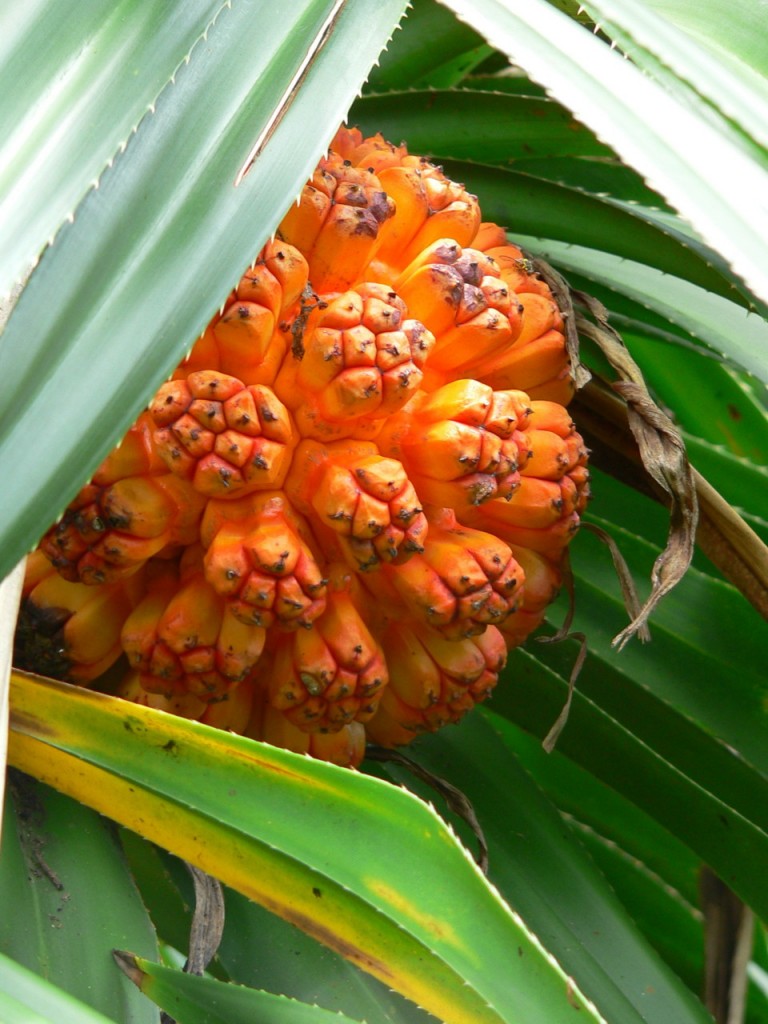
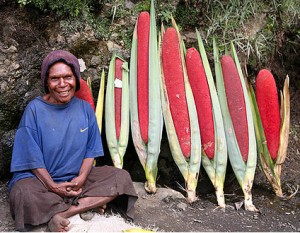
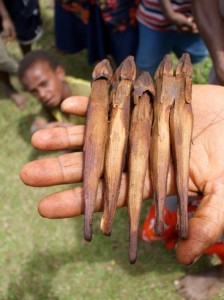
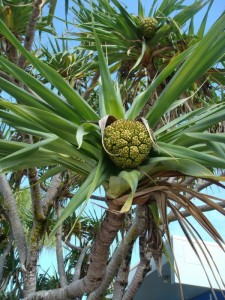
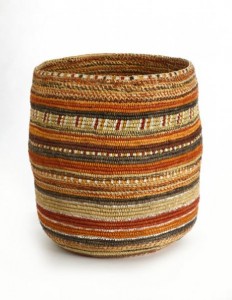
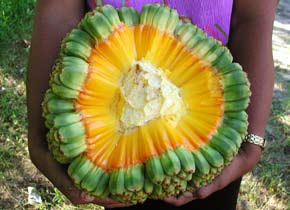
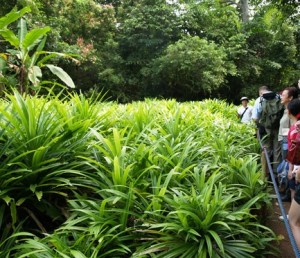
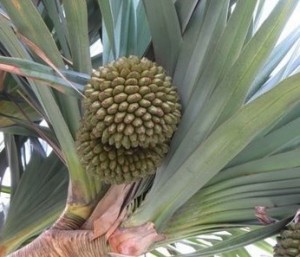
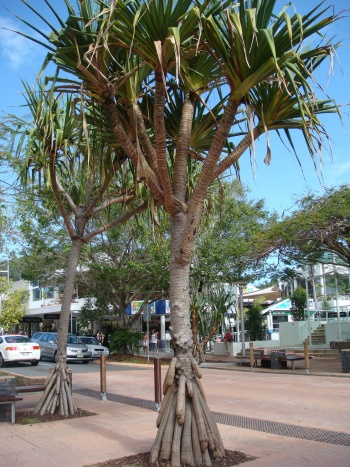
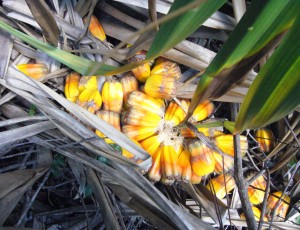

I always learn something from every single one of your posts. Cheers for this post regarding the tropical wonder we call pandanus. I have to say that as a Taswegian, the odds of me every growing one here are slim and next to none, BUT that doesn’t stop me admiring and enjoying posts like these 🙂
Pandanus juilianettii and Pandanus brosimos grow in a climatic zone where Banana passionfruit goes wild and climb over it – just like banana passion fruit does in Tasmania. At 2,800 m altitude in PNG the climate is similar to Tasmania!
I live in Tasmania too, in Miene mate.
WOW!! I live near the Gold Coast Australia and didn’t realize this plant is such a gem. Its grows mad here.
Love your stuff Dean, U Rule big time here mate.
Cheers from OZ 🙂
This is a fascinating article. Thanks for bringing it to my attention. I had no idea and will look for this fruit the next time I’m in Hawaii visiting my family. I’ll also look for baskets made from this trees leaves and bark.
Great article about Pandanus! So many options! Pandanus tectorius (and other pandanus) are great plant for coastal windbreaks.
Thanks for the info. I just learned a lot more about Pandanus… This looks like a fantastic website, I’m surprised I haven’t come across it before. I’ll be sure to tune in regularly. If you have a moment, could you tell me if I have the right ID on this Pandanus photo: http://anthropogen.com/2008/03/02/pandanus-spp-close/
The “Pandanus amaryllifolius” usually known just as Pandan in Malaysia and other South East Asian countries are used in making deserts. And we remove or discard the leaves. It’s too ‘hard’ for consumption. We would wash it, tie 3-4 leaves in a knot and boil in a pot of water with slices of old ginger and rock sugar to make syrups, or add more water and toss in sweet potato cubes in hues of colours. We call this the Sweet Potato Soup.
There is also the Bubur Cha-cha which also uses the Pandan leaves to flavor the ‘soup’.
Pandan can also be tossed into rice and some shallots with some fenugreek seeds and a bit of coconut cream to make a rice dish call Nasi Lemak (direct translation call “rice lard” but it is not lard. It’s a fragranty rice that goes well with curries. Have a try. 🙂 )
If you’re interested in the recipes, google the names.
The Pandan leaves could also be used to wrap pieces of marinated chickens and grilled. “Pandan Chicken”
Or made into square cups and filled with some type of coconut + water chestnut + mung bean flour. Eaten cold from fridge. Desert. Goggle for Kueh Tako Pandan.
Cheers!
celia
I have tried the flavoring from an Asian market, and I know it isn’t the same as the real thing, but it was a very unique and appetizing flavor! I would LOVE to get seeds or cuttings for the whole plant so I could use the leaves!
I have a very large Pandanus in my yard and its baring those round green fruit pods . I live in florida though can you still eat the fruit?? Its a very large tree i removed 17 pods off .
Most of them are edible when bright orange red. You would have to make sure of the species, though.
I also live in Florida. I have a pandanus utilis that just started falling apart on my counter, apparently ripe? my husband would like to know how, & what part to use to grow a tree of our own. Anyone know??
I hope you put the keys in soil and watered them. Every key can bear several seeds so be patient and leave the keys in the ground after their first offspring. It can take up to a year for all new plants to sprout.
I’ve asked one other person on this list but I’m asking you to if you are interested in selling some of your seeds to me if so get back with me thank you and if not please get back with me so I don’t keep watching have a great day faithweighall@ymail.com
I was reading this article and I read some of the comments would like to know if you were willing to sell some of your pod so that I might try to grow one myself if so please reply and faithweighall@ymail.com If not please let me know so I don’t keep watching just very much interested thank you and have a good day
My mom used to make baskets and bowls and placemats and hats! Growing up in Miami
Carl would you be willing to sell some of your pods? I would like to try the fruit. They say the are good for birds also and i would like to try them.
Thank you
Great info. about pandanus! I manage Pacific Pure Water in the Marshall Islands and produce panadanus juice and makwon, pureed pandanus, as well but there’s not a lot about it online. Love the stuff!
Thanks!
PS – It’s really tasty in a martini or margarita too!
Thanks. Have you tried all the species or are there just a few you prefer?
Very good article with great information. I bought what I was told was a Flax plant from a nursery in St Vincent (Grenadines). This year it grew many hard green fruits, which turned orange and burst. I think it’s a Screw Pine, Pandanus Tectorius. My garden is blasted by trade winds and salt but this plant withstands all of it. I put the chopped fruit in a blender with honey and coconut water, and strained the juice, it smelt like fresh mown grass and made a refreshing drink. Maybe we shouldn’t have drunk it! But everyone survived, maybe the fresh passion fruit vodkas to follow helped! I bought a Cleusa Rosa from the same nursery, it’s now 20′ tall and is full of mocking birds when the football fruits ripen.
hi all!
from my last trip to Asia,I brought with me some pandan seeds. does anyone know how i can end up planting them?
thanks
I from Singapore. Its very hard to grow from seeds. Much easier to grow from suckers.
can I plant a pandanus tree close to my house
Not too close. They form a huge clump that can grow as big as a house.
http://goilala.wordpress.com/2014/10/12/pandanus-in-pictures-goilala-2/
Does anyone know exactly the process of turning pandanus fruit/seeds into flour? I have some fruit and want to turn it into flour.
very interesting post. can these trees survive in central Alabama?
This article is certainly a good base because it prompts us to search for the number of edible, families, species, genus and varieties of Pandanus conoideus there are in the New Guinea Island.
this plants found n Markandi in odisha ,INDIA
Sir,
Will you please let me know, if I can get seeds ofthis plant and how.
Pandanus utilis is not from Madagascar.
The photo is not Pandanus utilis.
Sincerely
Alain
I drew this particular seed pod years ago. It was bought from the flower district in NYC. What is it if not the pandanus utilis?
These grow along Victoria Embankment in Durban.
It was wonderful to read up about this pineapple looking fruit.I discovered it this morning on my beach walk here in Hong Kong.
It is a good thing to know about this fruit,after a long years of ignorance on it well i will pass out this knowledge to other family and friends about this discovery here in my home country Nigeria,Delta .
Wow, 14g of protein per 100g in the seeds? 14% protein is a better protein density than a hard-boiled egg.
Great info and yet another treasure of the vegetable world.
We call it ‘Karuka’ (Pandanus julianettii) in Papua New Guinea Highlands (2000-3000 metres), very tasty and high in protein, best when cooked under the ground (mumu). There were four or so different kinds, we used to eat when I was a kid, but now there seems to be only one or two types. In the mid-highlands (1000-2000 metres), we have ‘marata’ (Pandanus conoideus), rich in oil with red or orange colors, boiled (or cooked in earth) and then squeezed to extract the oily flesh as a paste from the seeds. In the coast, we have the other the many other species.
Can pandanus veitchii leaves be used in cooking as with the other pandanus species typical for culinary usage?
I am very facinated with plants. I am wondering if any of these plants grow in Jamaica, West Indies.
Yes they do. I saw them on a recent trip to Portland. They’re plentiful
I love Pandanus amaryllifolius, I have used it to make tea. Pairs well with Cymbopogon flexuosus or C. citratus or any other species of lemongrass. I have also tried it with rice and have heard it being very popular in Thailand in doing so.
Pandanus tectorius in Hawai’i is a very important native canoe plant. It is known by two names which include hala ʻula (red Pandanus) or hala melemele (yellow Pandanus) I find it interesting that it has two seed dispersal mechanisms one being it is buoyant and the other attractive to animals which help disperse it. It is important to note that the cultivated varieties are approximately 10 times higher in bet-carotene than their wild counterparts.
Traditionally the soft part of the male flowers (hīnano) were chewed by a mother and given to infants and young children as a laxative, it can also be given to adults for the same purpose. It works well for thrush. The aerial root tips can be macerated, juice strained and heated, mix this with eucalyptus in a pūloʻuloʻu (steam bath) to treat colds. A friend of mine uses the massive pollen bearing flowers for skin problems as well. Also the aerial roots can be mixed with kō (sugar cane) and other plants which in ancient Hawai’i was used as a tonic for mothers weakened by child birth. The mixture has also been given for chest pains. Oh yea, aside from its important use for mats as you mentioned it makes a nice paintbrush too.
Question : to propogate a pandanus using large trunk roots. Does it need to be a root that it touching the ground? Can you plant as a long piece? Or would u cut the top off the root piece?
Hi
It’s really great to see infor about pandanus. Pandanus utilis (karuka) and pandanus conoideus (marita) are loved by many Papua New Guineans especially those from the higher altitude.
We just brought some seeds back from Kep in Cambodia and hope to grow them along the Mekong where we live. Thanks for the helpful information.
Hi Anyone know of any books on Pandanas bits and pieces in everywhere but havent found any books just on them
Australian publishers might have some.